Activity based workplace design
22 Dec 2025
Published on:
29 November 2019
Updated on:
23 October 2023
Read time:
Millennials will account for around 50% of the UK workforce in 2020. As they are joined by Generation Z, these age groups will dominate workplace environments by 2025. Companies will need to have a workplace they want to work in.

Digital technology, changing lifestyles and an emphasis on company culture have had a significant influence across every industry. Global communication also keeps everyone better informed. What۪s more, numerous scientific studies regarding health and wellbeing in the workplace has prompted a seismic shift in office design.
Physical space has a powerful effect on how employees experience their working environment. The emerging workforce expects companies to embrace digital technologies and provide a platform to be flexible, productive and creative.
Consequently, interior office designers have developed the concept of agile offices. These type of work environments fit modern on-the-go lifestyles, feature seamless integration of technologies and combine a variety of working areas that foster collaboration, privacy, focus areas and social hubs where employees can take a break and build bonds with colleagues.
The recent shift towards flexible working, and ultimately, agile offices, has been driven by millennials. Generation Z, born into an age of 24/7 connectivity and digital technology, is expected to influence working environments even more.
Millennials and gen-Zers are not interested in jobs with fancy titles and a bulging salary, they care about a work-life balance and spending their time in better work environments.
When the accounting giant Pricewaterhouse Coopers witnessed an employee exodus, executives commissioned a company-wide report to determine why so many young employees were leaving the company. It turned out millennials felt rewards should be awarded for the quality of work performed, not the amount of time you spend in the office.
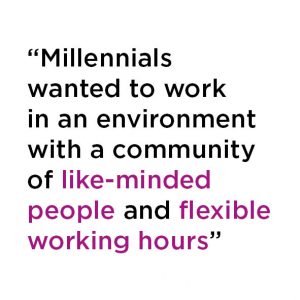
The report also discovered millennials wanted to work in an environment with a community of like minded people and flexible working hours. It۪s rare for people to work nine-to-five these days. As companies embrace telecommuting, employees have more flexibility and choices about where they work and when they work.
Both millennials and gen-Zers are tech-savvy. They are accustomed to being connected and comfortable using technology to facilitate their work. What۪s more, they are bemused by outdated computer systems. These age groups expect modern technologies such as wi-fi, cloud computing, automated software and smart buildings.
Ultimately, technology provides employees with the flexibility and choice they want to enjoy a work-life balance. Employers that understand this and invest in creating a frictionless digital experience for their workforce stand a better chance of retaining your best employees and attracting the top talent entering the marketplace.

What۪s more, both millennials and gen-Z share an acquired taste for unique and unconventional designs. You only need to walk into a hip cafe or club to recognise this.
The modern workforce also demands to work in an environment that caters for their health and wellbeing. Ergonomic furniture, mobile offices and biophilic elements embedded in the designs are essential. Equally important are firms that provide a sustainable workplace that helps protect the planet.
Agile working practices tie into modern ideals and reflect the culture and mindset of younger generations. It is no surprise that companies are choosing agile office designs to transform their working environment and ultimately, how they operate.
The goal of the agile office is to create an environment that gives employees more autonomy, freedom of choice and a platform to be as productive as possible. Essentially, agile working involves letting go of the traditional office space and changing the way in how you conduct operations.
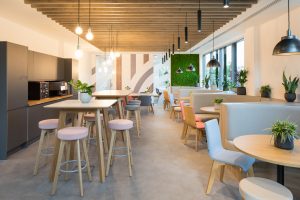
There are essentially three types of agile working; activity-based working (ABW), office hoteling and hot-desking. While all three strategies dispense with dedicated desk space, they work slightly differently.
ABW typically involves a free address protocol in which employees reserve desks, rooms and equipment, often moving from one place to another to work in an environment that best suits the activity they are performing.
Hot-desking operates on a first come first served basis but still gives employees the flexibility to move around the office if there is a free workstation available. In an office hoteling system, space is booked in advance for half or full day, but the employee has to stay there for the scheduled block of time.
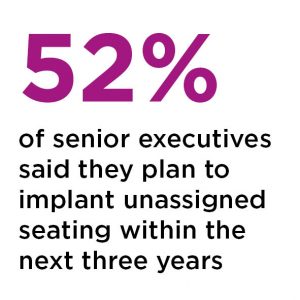
Because agile office designs present so many benefits, agile working is the fastest growing global trend across a number of key industries. A CBRE survey reveals that 52% of senior executives said they plan to implant unassigned seating within the next three years.
Agile office designs largely resemble open-plan office designs. The key difference is purpose-designed spaces that support the activity employees are performing.
For example, a typical agile office will consist of creative hubs where colleagues can collaborate, private booths that absorb sound and allow people to maintain focus, portable and reconfigurable furniture that can be adapted to individual needs, and social spaces where employs can take a break from work and relax with colleagues.
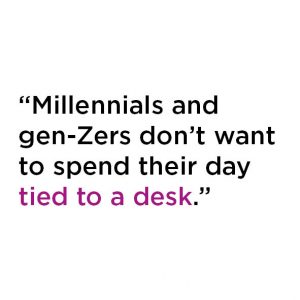
Millennials and gen-Zers don۪t want to spend their day tied to a desk. They want the freedom and the choice to be mobile. They also want to collaborate with colleagues, but also have a refuge where they can find peace and quiet to concentrate on focus orientated tasks.
As the first generation to be connected 24/7, work is something that is not easy to escape from. Millennials view their job as a thing and, thanks to cloud technology, you no longer need a dedicated place to go to perform office jobs.
Flexible working from home, cafes and hotels has become the norm for many businesses. However, having a divided workforce all over the city is not always easy for managers to keep track of. Companies want to encourage staff to stay in the office.
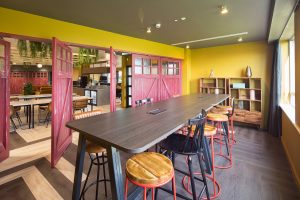
However, to accommodate the working preferences of a young workforce, firms need to design custom-built working environments that are dynamic and conducive to the activity that is being performed. Desks with adjustable height and chairs with removable backrests can be a good option.
Technology plays a central role by enabling companies to collapse the silos of departmentalisation in favour of creative and social hubs that support cross-functional teams.
Agile offices are also expected to provide a variety of workspaces where creative collaboration will thrive and social areas where employees can relax and eat.
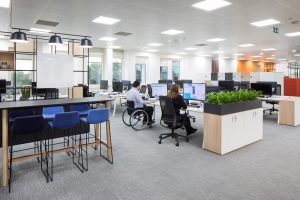
Although the modern workplace should be reimagined in a way that accommodates the millennials and generation-Zers, it must also allow older generations to feel comfortable. After working in the same way for years, changing habits can be difficult.
Some employees will prefer a dedicated desk where they feel comfortable and routined۪. Dedicated desks may also be a preference for introverted character types that prefer to be around people they know and feel comfortable with. To accommodate everyone in an agile working policy, you have to be flexible in your thinking as much as in the design.
Living in the information age has meant more people are better informed. With numerous studies highlighting the health risks of sedentary jobs, building contractors, commercial property owners and business leaders are turning their attention to building designs that cater towards the wellbeing of its occupants.

Poorly designed buildings and offices have culminated in what is being called sick building syndrome.۪ Symptoms are linked with the amount of time people spend indoors and include headaches, eye strain, irritation of the throat and nose, fatigue, dizziness and nausea. The cause is due to poor heating, ventilation
and air conditioning systems.
The Environmental Protection Agency in the US issued a report that indicates the air we breathe indoors is, on average, two to five times more toxic than the air we breathe outside. This is due to neurotoxins from bioaerosols like furniture and carpet cleaner together with car fumes and other toxic chemicals coming in from outside.
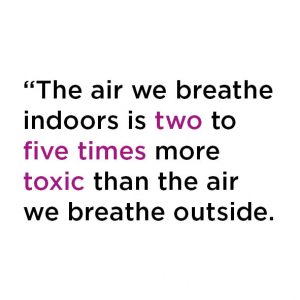
The World Green Building Council has called for commercial property owners to incorporate a holistic approach to increasing natural light, improving air quality and reducing noise in busy environments. A focus on wellbeing also plays into sustainability projects by lowering carbon emissions typically associated with buildings.
Experts claim the benefits of creating a healthy building far outweigh the cost. Work environments that protect the wellbeing of staff reduce illness and absenteeism, promote higher levels of productivity and performance and improves mood, happiness and job satisfaction.
The 9 foundations for health and wellbeing in an office are air quality, ventilation, lighting and views, thermal health, reduced noise, moisture-free, improved water quality, dust and pests and safety and security.
In addition, ergonomic furniture which employees can adapt to their height, size and comfort preferences are expected together with adjustable desks which can be used for working in both standing and sitting positions.
Moving to an agile working policy may require a shift in company policy and working practices but the world seems destined to adopt flexible working at some point. For the interests of business continuity, the sooner the better.
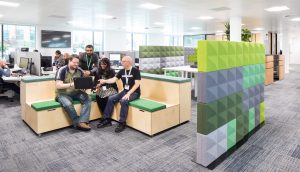
Organisations that are contemplating shifting towards agile working for strategic purposes must have trust and faith that their employees will work to the best of their ability when and wherever they are.
Providing a work environment that encourages staff to attend the office more often makes it easier for managers to check-in and encourages your workforce to collaborate, socialise and build bonds.
The case for agile working among millennials is growing and will be reinforced as gen-Zers arrive on the scene. Stylish workplace design and a healthy office environment that results in satisfied employees ultimately has a knock-on effect with performance, productivity and staff retention. The young ones have a strong case.